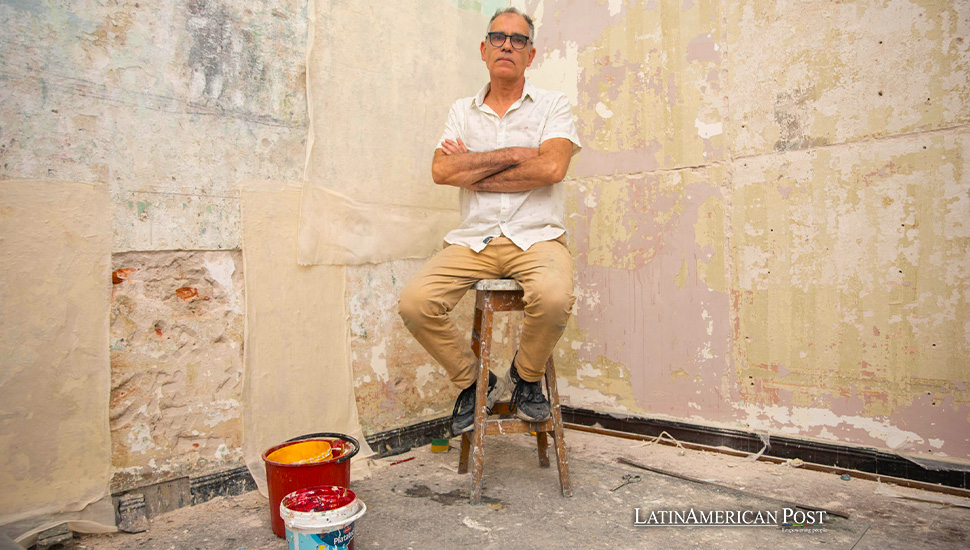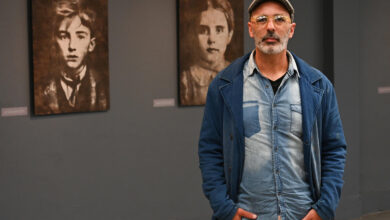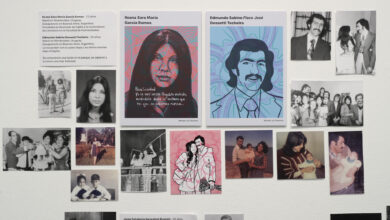The Uruguayan Eduardo Cardozo will “Undress” his Workshop at the Venice Biennale

Naked and with his skin “ripped off”, the artist Eduardo Cardozo’s workshop will be part of the installation with which he will represent Uruguay at the next Venice Biennale, where he also seeks to “meet” Tintoretto in a reinterpretation of ‘Paradise’.
Like the scars that the passage of time leaves on the skin of the human body, the marks on a wall tell its story and it is to this end that, in a foreign land, Cardozo will seek to make the space with which he most coexists speak: his workshop.
A foreigner in Venice
“Like any artist’s workshop, it is full of oil paint marks from when one splashes; when one generates perspectives, they are lines and strokes that are marked on the walls,” he says in an interview with Agencia EFE from his atelier.
Under the current layer, he points out, there are even more stories, those of those who previously lived between the walls painted and repainted in other colors with the decades that today he seeks to “tear off” to exhibit as part of ‘Latente’, the installation with which he will represent to his country in the most important art biennial in the world.
In its 60th edition which will open its doors on April 20 under the general curatorship of Brazilian Adriano Pedrosa, the Venice Art Biennale will have the theme ‘Foreigners everywhere’ as a celebration of “the foreign.”
It is along these lines that Cardozo chose to present himself to the call for projects of the Ministry of Education and Culture with a work of which his atelier will be part, which, he says, “is a bit foreign” because “it has nothing to do” with the surroundings where it arrives, in the capital of Italian Veneto.
“There is something of uprooting because I tear out the walls. The word uprooting comes from the plants when we uproot them and (from there) that idea of tearing out this wall with a little history. I take it there and it is going to be foreign in that place,” he remarks.
Tintoretto naked
Curated by Elisa Valerio, the installation will consist of three pieces that, as Cardozo highlights, Valerio decided to call “the nude”, “the veil” and “the garment”.
The first consists of the aforementioned exhibition of parts of the wall of his workshop extracted with the Italian “strappo” technique, used for the restoration of frescoes, and is linked to the second since the fabrics glued with rabbit glue to extract them will be hung and will make up “the veil”.
The third piece, meanwhile, goes hand in hand with the artist’s landing in Venice, because, he says, he always liked it when when visiting him one of his friends waited for him for a hug and he wanted to emulate this with a particular Venetian “friend”: the painter Jacopo Comin, known as Tintoretto (1518-1594).
To choose it, Cardozo, who defines himself “more than anything as a painter”, had as his motivation the recent restoration of one of his paintings, the sketch of ‘El Paraíso’ exhibited at the Thyssen-Bornemisza National Museum in Madrid.
In this process, he notes, the study of the canvas with X-rays left the artist “very exposed”, to which it was even discovered that he had painted the characters naked before painting their clothes over them.
“All of this in some way is the intimacy of the painting that is exposed; it has to do with the intimacy of my workshop as well, which is going to be exhibited (in Venice),” summarizes the person who will emulate the clothes from ‘Paradise’ with fabric to the third piece.
Universalism above all
With its pavilion acquired in 1960, by the national director of Culture of Uruguay, Mariana Wainstein, the country has its space in the architecture and art biennials of the city of canals is something “wonderful”, although it is “complex “The transfer of the works.
“About 800,000 people come to the Venice Biennale. It is one of the largest art gatherings in the world, if not the most important, so it is a very great opportunity to show what we are, that Uruguayan identity (…) that goes through culture,” he highlights.
Aware that the instance entails “a great responsibility,” Cardozo highlights the great “affection” he has for the project he will lead and says that his main expectation is “that people like it and understand it.”
Read also: Shakira, Karol G, and Peso Pluma are in Obama’s Favorite Music Selection in 2023
Furthermore, he emphasizes that “in a time when universalism is quite questioned” or there is a commitment to vindicate more the native over the universal, he is interested in “rescuing the concept of universality” with his work.
“For me, Tintoretto is a Uruguayan artist in a certain sense because he is universal. Dostoevsky is Russian but (…) when anyone in the world reads him they can feel it because he works with human issues,” he exemplifies and vindicates thinking. in universalism not so much as “appropriation” but more as “touching human things.”




